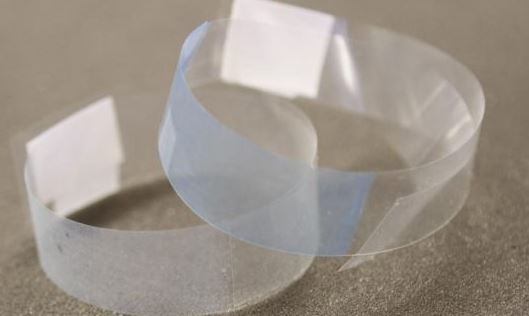Safer sunbathing - thanks to Queen’s! 
27 March 2015
A Queen’s University inventor has created an ingenious wristband that checks for sunburn while the wearer relaxes.
The blue plastic strip is worn as a bracelet which measures sun exposure, slowly changing colour and giving advanced warning to sunbathers and prompting them to get into the shade.
The device will soon become commercially available, said its inventor, Dr David Hazafy, a Research Fellow in the School of Chemistry and Chemical Engineering. “We have just started a company - SunCatalyst Laboratories - and plan to develop it,” he said.
“On the side of the band there will be a colour code so you know how much time you have left before getting out of the sun,” said Dr Hazafy.
The science behind the invention has been rewarded with a Royal Academy of Engineering Enterprise Fellowship, worth almost £85,000. The wristband, which uses a kind of “smart ink” that reacts with ultraviolet light from the sun to gradually break down the blue dye, is expected to go on sale for around £5.
The plastic strip, in the form of a bracelet, changes colour at a speed that depends on the wearer’s skin type and can be worn at the same time as sun lotion, allowing users to enjoy the sun while avoiding unnecessary risks – and painful sunburn.
 What makes the smart ink work is a photocatalyst, which harvests energy from sunlight to create chemical reactions. And it could be used in a much different way, as a light-driven antibacterial plastic film. So instead of bleaching out a dye the photocatalyst could instead to kill off harmful bacteria on hospital curtains, tiles and glass, to create a more sterile, safer environment.
What makes the smart ink work is a photocatalyst, which harvests energy from sunlight to create chemical reactions. And it could be used in a much different way, as a light-driven antibacterial plastic film. So instead of bleaching out a dye the photocatalyst could instead to kill off harmful bacteria on hospital curtains, tiles and glass, to create a more sterile, safer environment.
Dr Hazafy added: "The sunburn indicator works by using a photocatalyst and a redox dye in which the former absorbs the ultraviolet light and uses its energy to drive the change in the colour of the dye. The sunlight is collected throughout the day so the user... is warned when it nears the level which causes sunburn."
Speaking about the Fellowship which gives academics £85,000 each to develop their research into viable commercial products, Dr Hazafy, said: “The Royal Academy of Engineering is a great opportunity to receive funding for 12 months, as well as mentoring and training to develop business skills. It is hoped that the products will be put forward for trials within the next year.”
Photograph: Courtesy of SunCatalyst Laboratories, showing two prototype sunburn indicators, one with the blue dye (right) and one that has lost its colour after exposure to UV light that causes sunburn
Media inquiries to Elaine Fitzsimons on e.fitzsimons@qub.ac.uk or telephone (028) 9097 5310
Back to Main News
Top of Page